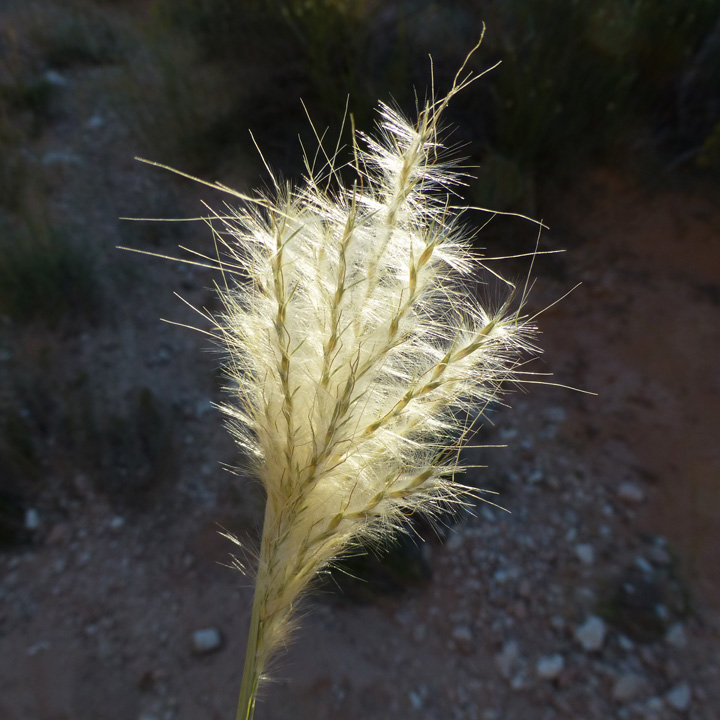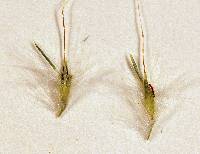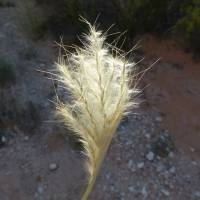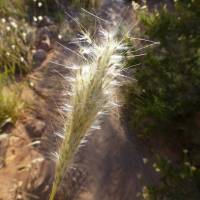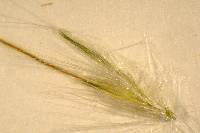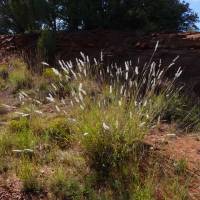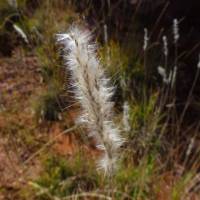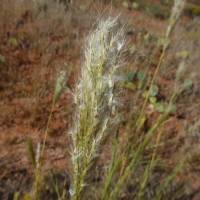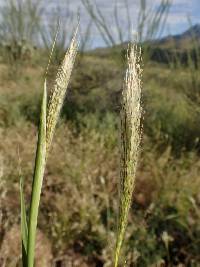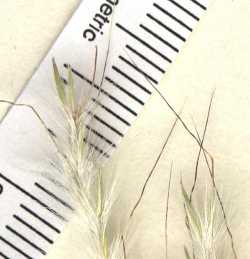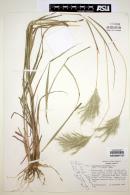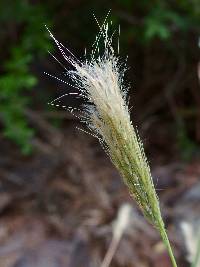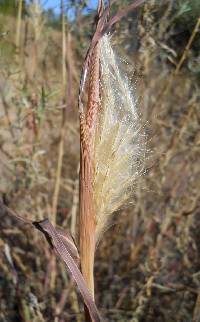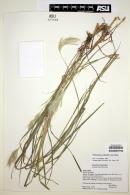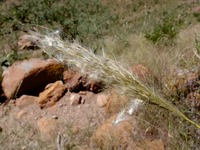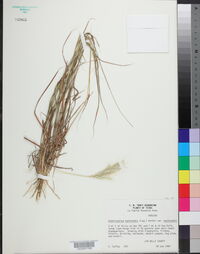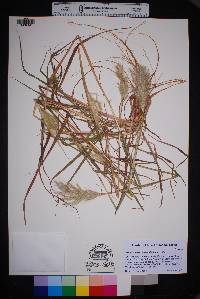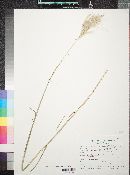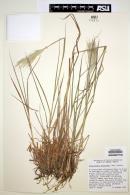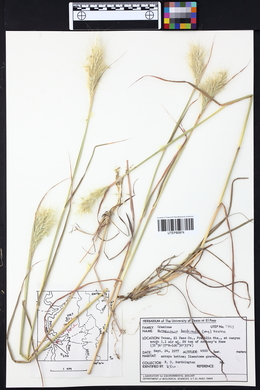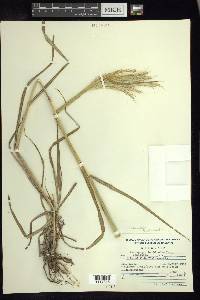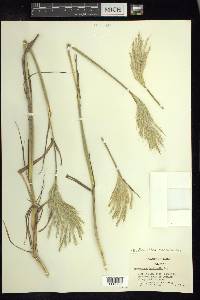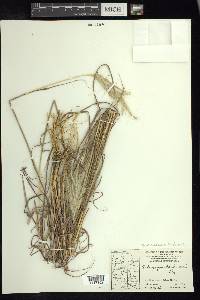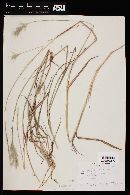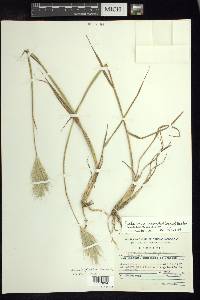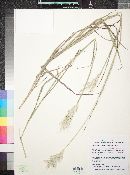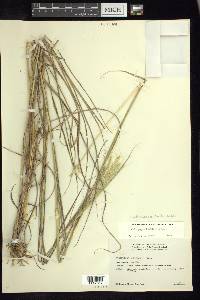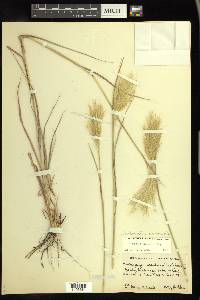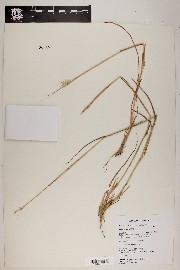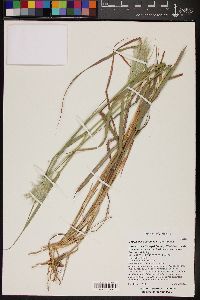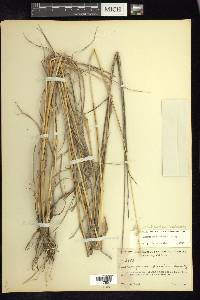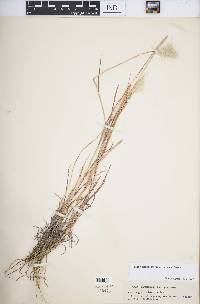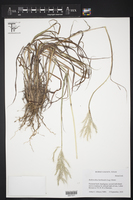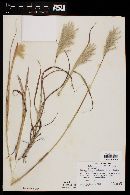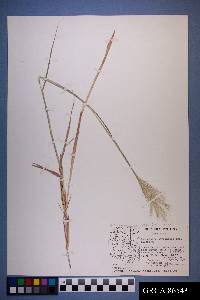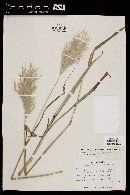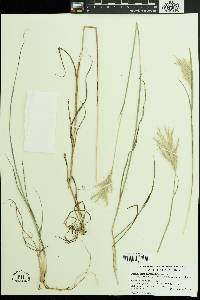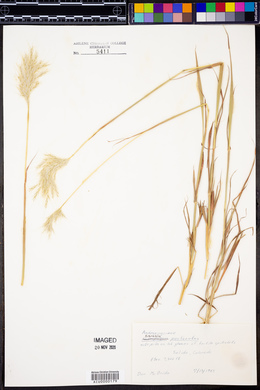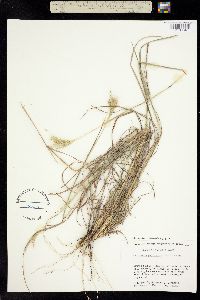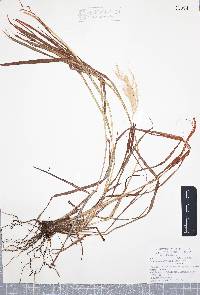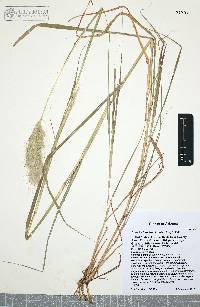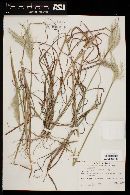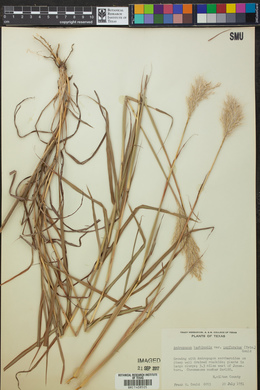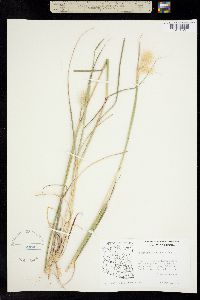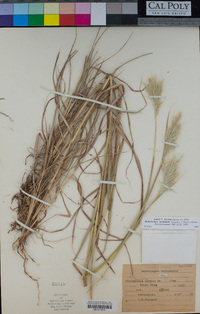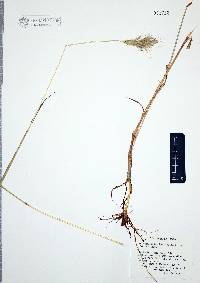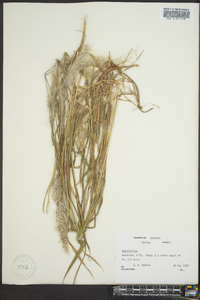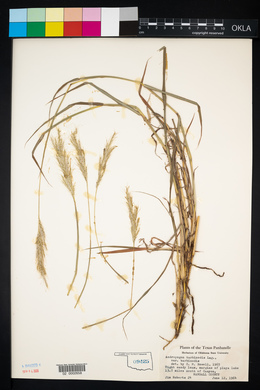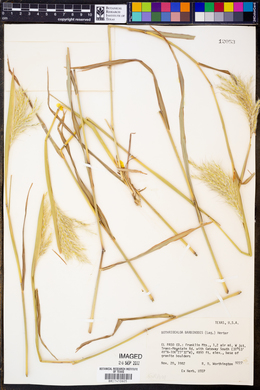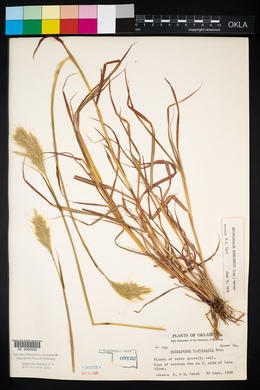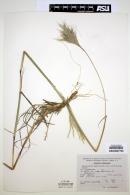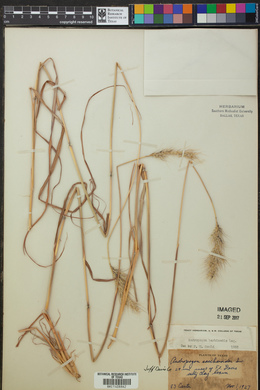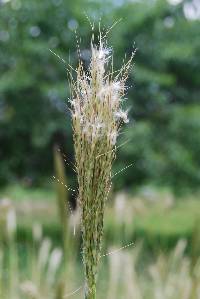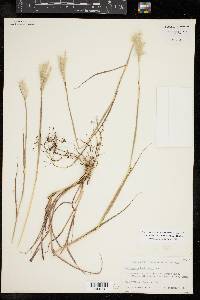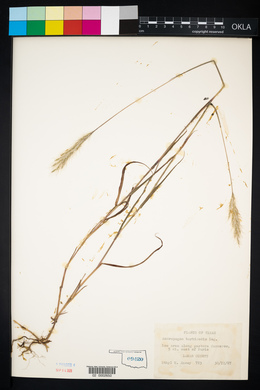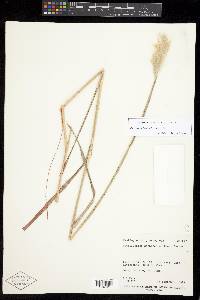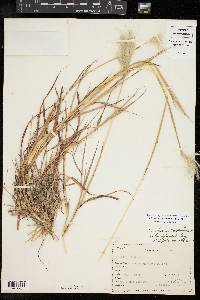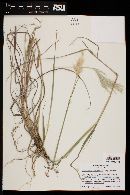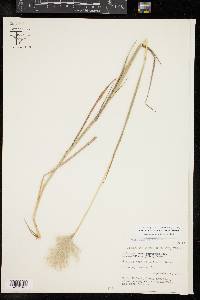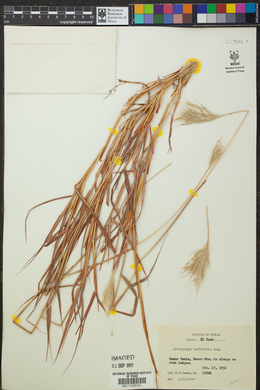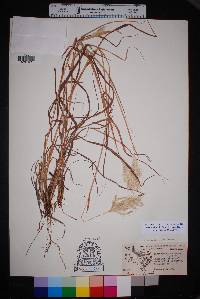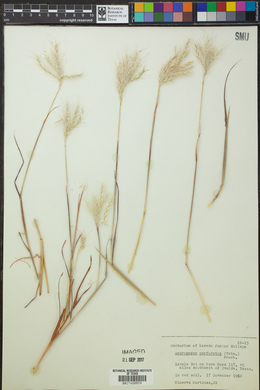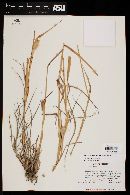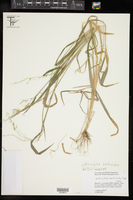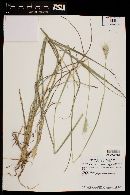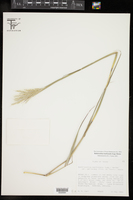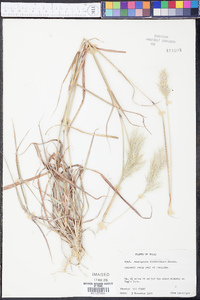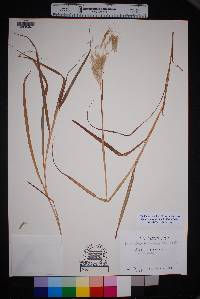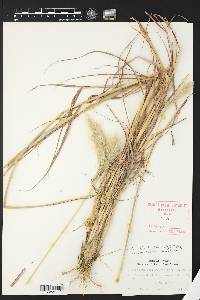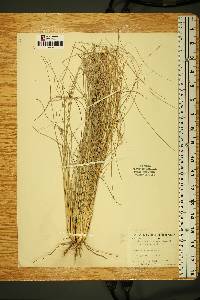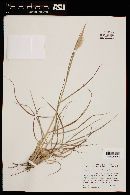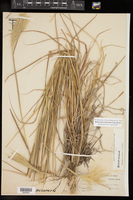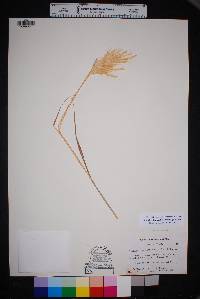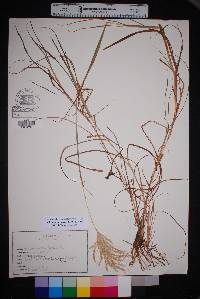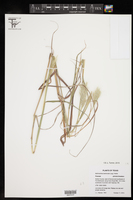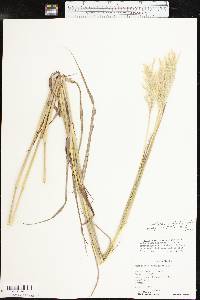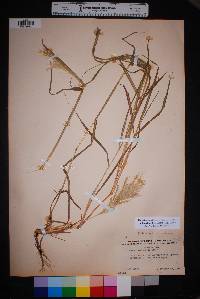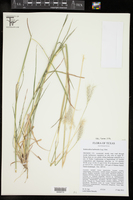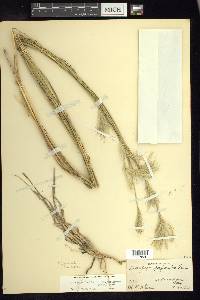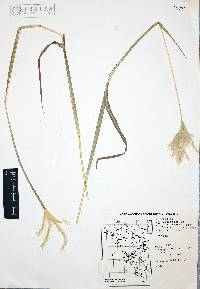
|
|
|
|
Family: Poaceae
Cane Beard Grass, more...cane bluestem, cane beardgrass, Palmer's cane bluestem, pitted beardgrass (es: popotillo algodonero, cola de coyote, zacate popotillo)
[Amphilophis barbinodis (Lag.) Nash, moreAmphilophis leucopogon (Nees) Nash, Andropogon barbinodis Lag., Andropogon barbinodis var. barbinodis , Andropogon barbinodis var. perforatus , Andropogon ischaemum var. barbinodis (Lag.) Desv., Andropogon leucopogon Nees, Andropogon perforatus Trin. ex Fourn., Andropogon saccharoides subsp. leucopogon (Nees) Hack., Andropogon saccharoides var. barbinodis (Lag.) Hack., Andropogon saccharoides var. palmeri , Andropogon schlumbergeri , Bothriochloa barbinodis var. palmeri (Hack.) de Wet, Bothriochloa barbinodis var. perforata (Trin. ex Fourn.) Gould, Bothriochloa leucopogon (Nees) Pilg., Bothriochloa palmeri (Hack.) Gould, Bothriochloa perforata , Holcus saccharoides var. barbinodis (Lag.) Hack., Sorghum saccharoides var. leucopogon (Nees) Nash ex Kuntze] |
Culms 60-120 cm tall, rarely more than 2 mm thick, erect, geniculate at the base, often branched at maturity, not glaucous below the nodes; nodes hirsute, hairs 3-4 mm, mostly erect to ascending, tan or off-white. Leaves cauline; ligules 1-2 mm, often erose; blades 20-30 cm long, 2-7 mm wide, not glaucous, glabrous or sparingly pilose near the throat. Panicles 5-14(20) cm on the larger shoots, oblong to somewhat fan-shaped, silvery-white; rachises 5-10 cm, straight, exserted or partially included in the sheath, with numerous branches; branches 4-9 cm, erect, with several rames; rame internodes with a membranous groove wider than the margins, margins densely pilose, longest hairs 3-7 mm, concentrated distally. Sessile spikelets 4.5-7.3 mm; lower glumes short pilose, with or without a dorsal pit; awns 20-35 mm; anthers 0.5-1 mm, often remaining within the spikelet. Pedicellate spikelets 3-4 mm, narrowly lanceolate, sterile. 2n = 180. Bothriochloa barbinodis is a common species, at 500-1200 m, along roadsides, drainage ways, and gravelly slopes in desert grasslands, from the southwestern United States through Mexico and Central America to Bolivia and Argentina, and has been found in the Hawaiian Islands. Plants with a pit on the back of their lower glumes occur sporadically; they do not differ in any other respect from those without pits. The species is sometimes used as an ornamental. It is tolerant of coastal conditions and will grow as far north as Vancouver, British Columbia. Bothriochloa barbinodis has been confused with three other species in the Flora region. It differs from B. wrightii in not having glaucous foliage, and in having oblong to merely somewhat fan-shaped panicles with pedicellate spikelets that are definitely shorter than the sessile spikelets; from B. alta in having shorter culms, panicles, and nodal hairs; and from B. springfieldii in having taller culms, wider leaves, shorter nodal hairs, and more, less hairy panicles branches. Dr. David Bogler, USDA NRCS PLANTS Database Perennials, Terrestrial, not aquatic, Stems nodes swollen or brittle, Stems erect or ascending, Stems geniculate, decumbent, or lax, sometimes rooting at nodes, Stems caespitose, tufted, or clustered, Stems terete, round in cross section, or polygonal, Stems branching above base or distally at nodes, Stem nodes bearded or hairy, Stem internodes solid or spongy, Stems with inflorescence less than 1 m tall, Stems with inflorescence 1-2 m tall, Stems, culms, or scapes exceeding basal leaves, Leaves mostly cauline, Leaves conspicuously 2-ranked, distichous, Leaves sheathing at base, Leaf sheath mostly open, or loose, Leaf sheath hairy, hispid or prickly, Leaf sheath and blade differentiated, Leaf blades linear, Leaf blades 2-10 mm wide, Leaf blades mostly flat, Leaf blade margins folded, involute, or conduplicate, Leaf blades mostly glabrous, Ligule present, Ligule an unfringed eciliate membrane, Inflorescence terminal, Inflorescence with 2 or more spikes, fascicles, glomerules, heads, or clusters per culm, Inflorescence a panicle with narrowly racemose or spicate branches, Inflorescence a panicle with digitately arranged spicate branches, Inflorescence branches more than 10 to numerous, Inflorescence branches paired or digitate at a single node, Inflorescence branches paired racemes, V-shaped, Peduncle or rachis scabrous or pubescent, often with long hairs, Rachis dilated, flat, central axis to which spikelets are attached, Rachis grooved, Flowers bisexual, Spikelets pedicellate, Spikelets dorsally compressed or terete, Spikelet less than 3 mm wide, Spikelets with 1 fertile floret, Spikelets with 2 florets, Spikelets paired at rachis nodes, Spikelets in paired units, 1 sessile, 1 pedicellate, Pedicellate spikelet rudimentary or absent, usually sterile, Spikelets bisexual, Spikelets disarticulating below the glumes, Spikelets disarticulating beneath or between the florets, Spikelets falling with parts of disarticulating rachis or pedicel, Rachilla or pedicel glabrous, Glumes present, empty bracts, Glumes 2 clearly present, Glumes equal or subequal, Glumes equal to or longer than adjacent lemma, Glumes 3 nerved, Lemmas thin, chartaceous, hyaline, cartilaginous, or membranous, Lemma 1 nerved, Lemma glabrous, Lem ma apex acute or acuminate, Lemma distinctly awned, more than 2-3 mm, Lemma with 1 awn, Lemma awn 2-4 cm long or longer, Lemma awned from tip, Lemma awn once geniculate, bent once, Lemma margins thin, lying flat, Lemma straight, Stamens 3, Styles 2-fid, FNA 2007, Gould 1980 Common Name: cane bluestem Duration: Perennial Nativity: Native Lifeform: Graminoid General: Robust tufted perennial grass, 60-120 cm tall, geniculate at base and erect above, usually villous with dense tufts of long, white hairs at nodes, at ligules and on inflorescences. Vegetative: Ligules 1-2 mm, often irregularly toothed; blades 20-30 cm long, 2-7 mm wide, drying reddish-brown, the bases semi-persistent, flat. Inflorescence: Panicles on the larger shoots, cottony and white or silvery, 7-14 cm, oblong to somewhat fan-shaped with numerous branches clustered at the top of the tall, nearly naked stems and emerging from a sheath; rachis joints and pedicels with hairs to 6-8 mm; spikelets in pairs, the sessile spikelet with 2 florets and the pedicillate spikelet sterile; glumes equal but different shapes, lower glume broad, green and flat to concave on the back, upper glume markedly humpbacked or V-shaped with a blunt keel. Upper lemma of sessile spikelet tipped with a twisted, geniculate awn 20-35 mm. Ecology: Found in open range lands, on dry, rocky or sandy slopes and plains, and graded roadsides from 1,000-6,000 ft (305-1829 m); flowers August-September. Distribution: Widespread throughout much of the southern half of the US; extends south through Mex. and Central Amer, to Argentina. Notes: Large perennial bunchgrass; immediately obvious is the tuft of hairy spikelets of the inflorescence which emerge from leaf sheaths. The dense tuft of hairs at the nodes is also diagnostic. Distinguished from other Bothriochloa in the region by having pedicillate spikelets much shorter than sessile spikelets and awns 20-35 mm. This plant responds very well to fire and is a prolific seed producer. Also a valuable forage species. The fresh seeds smell like blueberries when crushed or rubbed to release the scent. Ethnobotany: Unknown; other species in this genus have medicinal uses. Etymology: Botriochloa is from the Greek bothros, a pit or hole, and chloe or chloa, grass. Synonyms: Andropogon barbinodis, A. perforatus, Bothriochloa barbinodis var. palmeri, B. barbinodis var. perforata, B. palmeri Editor: SBuckley 2010, FSCoburn 2014, AHazelton 2015 |
|
|
|

